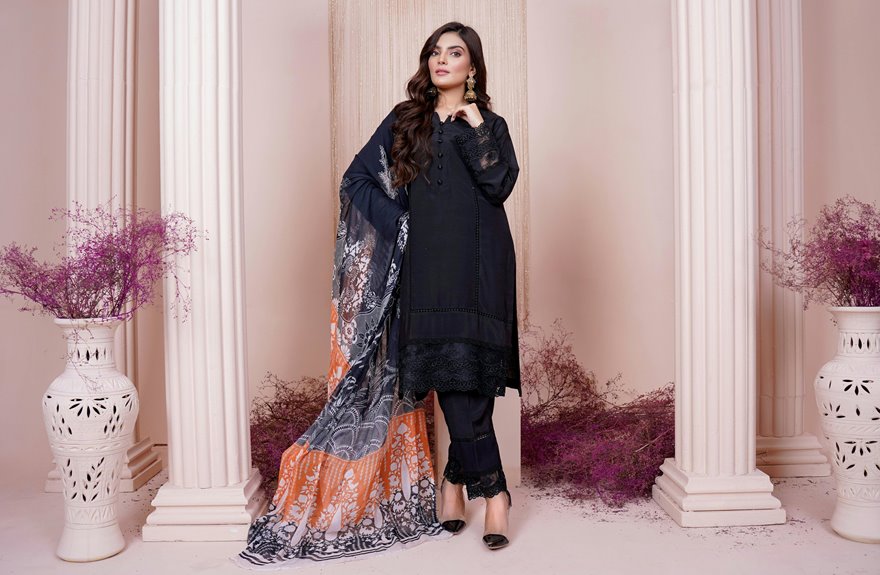If you want a lightweight, slightly textured fabric that’s airy and flowy, Georgette is your go-to for casual or semi-formal wear. But if you prefer a smooth, elegant drape with a soft sheen for polished, sophisticated looks, Crepe De Chine suits you better. Both are sheer and delicate, yet care varies—Georgette needs gentler handling, while Crepe offers a refined finish. Learn more to find which fabric matches your style and project perfectly.
Table of Contents
Key Takeaways
- Georgette offers a lightweight, airy feel with a slightly rough texture, ideal for flowy, casual to semi-formal garments.
- Crepe De Chine features a smooth, satiny texture with a subtle sheen, perfect for elegant and polished clothing.
- Georgette drapes softly with volume, while Crepe De Chine clings gently for a sleek silhouette.
- Georgette is easier to care for with hand washing, whereas Crepe De Chine often requires dry cleaning or gentle handling.
- Choose Georgette for breathable comfort and texture; select Crepe De Chine for refined sophistication and a smooth finish.
What Is Georgette Fabric?
Georgette fabric is a lightweight, sheer material known for its slightly crinkled texture and fluid drape. When you wear or work with georgette, you’ll notice it feels soft yet has a subtle roughness due to its crepe-like finish.
This fabric is usually made from silk or synthetic fibers like polyester, offering durability and ease of care. You’ll appreciate how georgette’s textured surface adds visual interest without overwhelming your design.
Because it drapes so well, it’s perfect for flowy dresses, blouses, and scarves that move gracefully with you. Unlike some sheer fabrics, georgette doesn’t cling tightly, giving you breathability and comfort.
When handling georgette, you’ll find it slightly stretchy and forgiving, making it versatile for various styles.
What Is Crepe De Chine Fabric?
You’ll find Crepe De Chine made from fine silk or synthetic fibers, giving it a smooth yet slightly textured feel.
Its soft drape and subtle matte finish make it a favorite for elegant blouses and dresses.
Let’s explore what sets this fabric apart and how it’s commonly used in fashion.
Fabric Composition Details
Crepe de Chine fabric combines a lightweight, smooth texture with a subtle crinkled appearance that sets it apart from other silks.
When you look into its composition, you’ll find it’s traditionally made from 100% silk fibers, which give it that luxurious feel and natural sheen.
However, modern versions might blend silk with synthetic fibers like polyester to enhance durability and reduce cost.
The key to Crepe de Chine’s structure lies in its tightly twisted yarns, woven in a plain weave that creates a fine, balanced fabric.
This construction not only offers softness but also prevents excessive stretch.
Texture and Appearance
The tightly twisted yarns and plain weave not only shape the fabric’s strength but also influence its distinctive texture and appearance.
When you touch Crepe De Chine, you’ll notice its smooth, slightly crinkled surface, which gives it subtle texture without roughness. Unlike heavier fabrics, it drapes gracefully, flowing softly with your movements.
Crepe De Chine has a matte finish with a gentle sheen that catches light beautifully, adding understated elegance to your garment. You won’t find the pronounced graininess of other crepes here; instead, it feels refined and polished.
This fabric’s balanced texture makes it versatile—it’s neither too stiff nor overly delicate, so it holds its shape while offering comfort.
When you choose Crepe De Chine, you get a fabric that looks luxurious yet feels approachable.
Common Uses
Silk lovers and fashion designers often turn to Crepe De Chine fabric for its versatility and elegance. If you’re looking to create flowy blouses, dresses, or scarves, this fabric is a perfect choice.
Its smooth yet slightly textured surface drapes beautifully, making it ideal for both casual and formal wear. You’ll also find Crepe De Chine in lingerie and nightwear due to its soft, breathable nature.
Beyond clothing, it’s used in accessories like ties and handkerchiefs, adding a refined touch. Thanks to its durability and resistance to wrinkles, it’s great for pieces you want to last and maintain a polished look.
Key Differences in Texture and Appearance
Although you might find both fabrics lightweight and elegant, georgette stands out with its slightly rough, pebbled texture, while crepe de chine feels smooth and satiny to the touch.
When you look closely, georgette’s texture creates a subtle matte finish with a natural graininess, adding visual interest and depth. In contrast, crepe de chine offers a refined sheen and a silky surface that catches light softly, giving it a more polished appearance.
You’ll notice georgette’s crinkled surface offers a casual, textured look, while crepe de chine’s smoothness lends itself to sleek, sophisticated styles.
These differences not only affect how the fabric feels but also influence the overall aesthetic you achieve, helping you choose the perfect fabric for your desired look.
Comparing the Weight and Drape
When you handle georgette and crepe de chine, you’ll notice they differ considerably in weight and drape.
Georgette is lighter and airier, with a slightly rough texture that gives it a lively, flowing movement. It drapes softly but with more volume, making it ideal if you want fabric that holds shape without feeling heavy.
On the other hand, crepe de chine has a smoother finish and a bit more weight, which allows it to drape elegantly and cling gently to your body. Its fluidity is more refined and less textured, giving garments a sleek silhouette.
Understanding these differences helps you choose the fabric that best suits the silhouette and feel you want for your project.
Best Uses for Georgette
You’ll find georgette works great for flowy dresses, blouses, and skirts that need a lightweight feel.
It’s perfect for both casual and formal occasions, offering a versatile look you can dress up or down.
Plus, its breathable fabric makes it a smart choice for warmer seasons.
Ideal Garment Types
A versatile fabric, georgette works wonderfully for garments that need a light, flowing feel with a hint of texture. You’ll find it perfect for dresses that drape beautifully and blouses that add a soft touch to your outfit. Georgette also excels in skirts and scarves, where its airy quality shines. Because it holds pleats well, it’s a great choice if you want subtle volume without stiffness.
| Garment Type | Why Georgette Works |
|---|---|
| Dresses | Flowy, lightweight, textured |
| Blouses | Soft drape, comfortable |
| Skirts | Airy, holds shape well |
| Scarves | Lightweight, elegant fall |
| Eveningwear | Adds sophistication and movement |
Occasion Suitability
The light, flowing nature of georgette makes it ideal for a variety of occasions where comfort and elegance matter.
If you’re attending a wedding or a cocktail party, georgette’s graceful drape adds a touch of sophistication to your outfit. It works beautifully for evening gowns, formal blouses, and dressy skirts, allowing you to move freely without sacrificing style.
You’ll also find it perfect for semi-formal events, like garden parties or brunches, where you want to look polished yet relaxed.
Georgette’s slightly sheer texture gives your attire a delicate, feminine feel, making it a go-to choice when you want to impress without feeling weighed down.
Whether it’s a romantic date or a festive celebration, georgette keeps you comfortable and chic.
Seasonal Wear Benefits
Although georgette’s lightweight and breathable qualities make it especially suited for warmer months, its versatility extends beyond just summer wear.
You can easily layer georgette garments during cooler seasons without feeling weighed down. Its slightly textured surface traps a bit of warmth, making it comfortable for spring and early fall.
Plus, georgette’s drape works well for both flowy dresses and tailored blouses, so you can adapt your wardrobe year-round. When paired with jackets or cardigans, it offers stylish layering options.
So whether you’re dressing for a hot summer day or a mild winter evening, georgette provides flexible wear that keeps you comfortable and chic across seasons.
It’s a great fabric to invest in if you want pieces that shift smoothly throughout the year.
Best Uses for Crepe De Chine
You’ll find Crepe De Chine excels in creating elegant garments that drape beautifully and feel soft against the skin.
It’s perfect for blouses, dresses, and skirts where you want a smooth, flowing look without excessive cling. Thanks to its lightweight yet opaque nature, it works well for formal wear, including evening gowns and bridal attire, offering a luxurious finish.
You can also rely on Crepe De Chine for tailored pieces like shirts and lightweight jackets, as it holds structure while remaining comfortable. Its subtle texture adds visual interest without overwhelming designs.
If you’re aiming for a polished, sophisticated appearance with versatility across seasons, this fabric fits the bill. It’s especially ideal when you want a balance between softness and durability in your wardrobe staples.
Care and Maintenance Tips for Each Fabric
When caring for Georgette and Crepe De Chine, understanding their unique fiber qualities guarantees your garments stay beautiful longer.
For Georgette, hand wash gently in cold water or use a delicate cycle with mild detergent to prevent damage to its textured surface. Avoid wringing; instead, press out water softly and lay flat to dry.
Crepe De Chine, often silk-based, requires even gentler care—hand wash with cold water or dry clean to preserve its smooth finish and sheen. Avoid bleach and direct sunlight for both fabrics to prevent fading.
Crepe De Chine demands gentle hand washing or dry cleaning to maintain its smooth texture and vibrant sheen.
Iron on low heat with a pressing cloth to avoid scorching.
Choosing the Right Fabric Based on Your Project Needs
How do you decide which fabric suits your project best? Start by considering the garment’s purpose.
If you want flowy, lightweight dresses or blouses with a slightly textured finish, georgette is your go-to. It drapes beautifully and holds pleats well, making it ideal for casual and semi-formal wear.
On the other hand, if you need a smooth, luxurious fabric with a subtle sheen for elegant blouses or eveningwear, crepe de chine fits perfectly. It offers a finer texture and a bit more structure.
Also, think about care—georgette may require gentler handling, while crepe de chine is slightly more durable.
Frequently Asked Questions
Are Georgette and Crepe De Chine Fabrics Suitable for Upholstery?
You shouldn’t use georgette or crepe de chine for upholstery since they’re lightweight, delicate fabrics. They’re better suited for clothing and drapes, not the heavy wear upholstery requires to stay durable and look good over time.
Can These Fabrics Be Dyed at Home?
You can dye both fabrics at home, but you’ll need gentle dyes and careful handling since they’re delicate. Test a small piece first, and always follow dye instructions to avoid damaging the fabric or altering its texture.
Do Georgette and Crepe De Chine Fabrics Shrink After Washing?
Did you know 70% of delicate fabrics shrink after improper washing? Both georgette and crepe de chine can shrink if washed in hot water or dried aggressively. Always hand wash in cold water and air dry to keep them pristine.
Which Fabric Is More Eco-Friendly to Produce?
You’ll find that crepe de chine typically uses silk, which requires intensive resources, whereas georgette can be made from synthetic fibers, often less eco-friendly. So, choosing organic or recycled fibers matters more than the fabric type itself.
Are These Fabrics Breathable for Summer Wear?
Did you know 60% of people feel uncomfortable in summer fabrics? You’ll love how both georgette and crepe de chine breathe well, keeping you cool and comfortable during hot days without sacrificing style or elegance.
- Is Cotton Typically Woven or Nonwoven? - July 11, 2025
- Is Chenille a Woven or Nonwoven Fabric? - July 11, 2025
- How to Tell if Fabric Is Woven or Nonwoven - July 10, 2025







